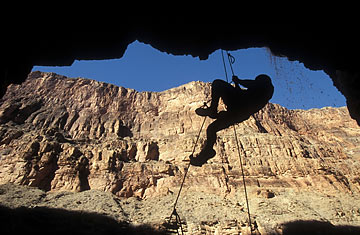
If willingly plunging thousands of feet below the earth's surface to risk disease, treacherous terrain and deadly waters doesn't sound like your idea of a good time, then supercave exploration may not be your calling. Yet that's exactly what a unique group of under-the-radar scientists and explorers has been doing for years. In his thrilling new book Blind Descent, James Tabor examines these fearless pioneers and documents the quest for the deepest place on earth. Tabor spoke to TIME about the dangers of caving and man's fascination with the unknown.
On nearly every page in this book, you write about all the things that can go wrong: disease, drowning, eternal darkness. Why do people do this?
At the very deepest level, there are some people that, when they look at a high mountain or a deep ocean or a bizarre cave, something really deep, deep, deep in them says, "I've got to go there." It's almost an irresistible impulse. Bill Stone, one of the great explorers profiled in the book, has said that he does this because he has to, implying a lack of volition. These people are also very serious scientists, and there is good science coming out of these big caves. But I think at the deepest level, it's almost ineffable — something very difficult to express but also difficult to resist.
How does cave exploration compare with mountain climbing in terms of danger and difficulty?
Supercave exploration has been likened to doing Mount Everest in reverse. There are so many different varieties of danger and complications in caves. You can drown, you can be hit with poison gases, you can be buried under rockfall. The scuba-diving aspect of cave exploration adds a whole other dimension of danger that even the great Himalayan mountaineers don't have to encounter. Mountaineers are probably going to hate me for saying this, but all things considered, I think there are more strange ways to die and get hurt in these supercaves.
Bill Stone is portrayed as an extremely polarizing figure, and he was known not to take to writers very well. What was your experience like with him?
In the beginning, Bill was very wary and standoffish. It took nine or 10 months before I was able to get the first face-to-face meeting with Bill. Once he learned that I had some caving experience of my own, I think that helped gain his confidence, and as the relationship evolved and I began to ask questions and actually ask him to review parts of the manuscript, he became more comfortable with the fact that this was not really a hatchet job. I just can't say enough good things about how helpful he was.
Krubera, in the Republic of Georgia, has been certified as the world's biggest cave. Just how big is it?
7,188 ft. is the final depth, so seven Empire State buildings. It is nine miles of travel from the entrance of the cave down to the terminus. It would typically take five to seven days for the explorers just to get down. They would stay down there for a week or 10 days, as long as they could stand it, and then it would take them a week to get out. So some of them were underground for a month.
What has cave exploration added to scientific knowledge?
Out of some very deep caves are coming life-forms called extremophiles. We are beginning to create new families of antibiotics from these things, which in turn are proving effective against multiply drug-resistant bacteria. Things like strep A, some forms of pneumococcus. These are things that all of our drugs have stopped working against, and these new antibiotics could quite possibly stave those things off. NASA is studying these teams that are underground under these incredible stresses for weeks and weeks at a time because they replicate, better than any simulation can, the experience that Mars crews are going to have on long-haul spaceflights.
What are the most impressive aspects of caving?
The first thing that hits you is the darkness. It has a palpable feel because you know if you lose your light, the darkness is probably the thing that is going to kill you. The other thing that continues to surprise me is that big caves are characterized not so much by tight squeezes and constrictions but by vast open spaces underground. I was in a cave in Tennessee where there was a chamber literally as big as Grand Central [Terminal]'s main concourse. Then, of course, there is the water. The hazards and the bizarre qualities of dives in caves is just astonishing.
Aside from Krubera, what are some of the world's biggest caves?
I coined the term supercave because, having become familiar with mountains, I knew that there was a name for this very special category of mountains that are more than 8,000 m high. There are only 14 of them, and they are called 8,000-m peaks. There was no similar term that designated this particular group [of caves], so I started calling them supercaves. There are only about a half dozen of them because you have to have very specific geological conditions for them to form. There are some in southern Mexico, the Republic of Georgia, Turkey, China, and there are some in Central Europe in the French and Italian Alps.
So there are no supercaves in the U.S.?
None in the U.S. We do have the longest cave known on earth, which is Mammoth Cave. It has hundreds of miles of passages, but you can't really call it a true supercave because you don't get miles deep. But we do have the longest, we can say that.
